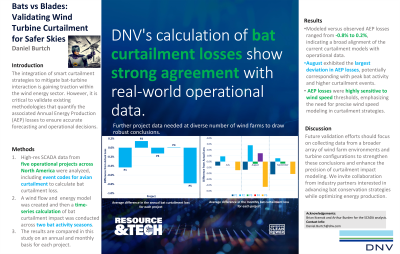Back

Bats vs. Blades: Validating Wind Turbine Curtailment for Safer Skies
Tuesday, October 1, 2024
5:00 PM – 6:00 PM MST
Location: Regency D

- DB
Daniel Burtch, M.Sc.
Senior Energy Analyst
DNV
Phoenix, Arizona
Poster Presenter(s)
Presentation Description: The interaction between wind turbines and wildlife, particularly birds and bats, has been a significant concern within the wind energy sector. A 2021 study by the Renewable Energy Wildlife Institute highlighted that bat fatalities could be reduced by up to 63% through the implementation of targeted curtailment strategies. However, the research also indicated a need for further studies to assess the impact of higher cut-in speeds on reducing bat fatalities even more effectively.
The American Clean Power Association (ACP) highlights that such curtailment strategies are beneficial for wildlife protection, but typically result in up to a 5% loss in annual energy production (AEP). This trade-off has led to an increase in the development of more intelligent curtailment strategies. Despite progress in this area, ongoing validation of these methods is crucial to ensure they accurately reflect potential AEP losses for specific wind farms.
DNV will present a detailed validation of its bat curtailment methodology. This will involve a comparative analysis using high-resolution operational SCADA data from various North American projects to assess actual versus predicted losses. Additionally, DNV will explore how variations in input data—such as wind speed data duration and resolution, environmental conditions, and time-of-day specifications—affect the accuracy of bat curtailment loss predictions.
This analysis will clarify uncertainties in curtailment loss estimations and improve methodologies, enhancing the precision of predictions and preparing for future regulatory changes regarding bat conservation. This will enable more effective and economically viable strategies that protect wildlife while optimizing wind farm efficiency.
The American Clean Power Association (ACP) highlights that such curtailment strategies are beneficial for wildlife protection, but typically result in up to a 5% loss in annual energy production (AEP). This trade-off has led to an increase in the development of more intelligent curtailment strategies. Despite progress in this area, ongoing validation of these methods is crucial to ensure they accurately reflect potential AEP losses for specific wind farms.
DNV will present a detailed validation of its bat curtailment methodology. This will involve a comparative analysis using high-resolution operational SCADA data from various North American projects to assess actual versus predicted losses. Additionally, DNV will explore how variations in input data—such as wind speed data duration and resolution, environmental conditions, and time-of-day specifications—affect the accuracy of bat curtailment loss predictions.
This analysis will clarify uncertainties in curtailment loss estimations and improve methodologies, enhancing the precision of predictions and preparing for future regulatory changes regarding bat conservation. This will enable more effective and economically viable strategies that protect wildlife while optimizing wind farm efficiency.
